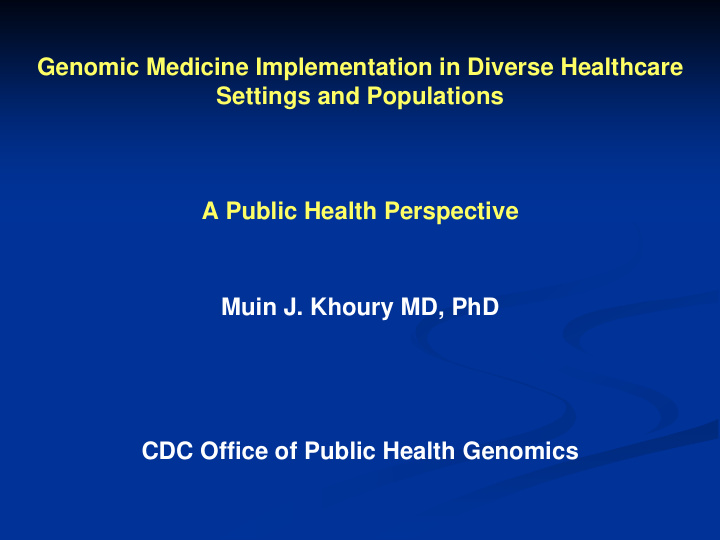



Genomic Medicine Implementation in Diverse Healthcare Settings and Populations A Public Health Perspective Muin J. Khoury MD, PhD CDC Office of Public Health Genomics
Outline Exploring the Intersection of Genomic (and Precision) Medicine, Implementation Science, and Public Health Public Health Genomics and Cancer: Case Study The Genomics and Population Health Action Collaborative (of the NASEM Roundtable on Genomics & Precision Health)
Epidemiology, Implementation Science and Precision Medicine: A Growing Intersection Implementation Science Public Health “Identify, understand, and “What we as a society do develop to increase collectively to assure the adoption, adaptation, conditions in which people integration, scale-up and can be healthy.” sustainability of evidence- ? based interventions, tools, policies, and guidelines” Genomics & Precision Medicine “Emerging approach to disease treatment & prevention that takes into account information on genes, environment & lifestyles”
Numerous Genomic Tests are Available
An Expanded Genomics Translation Cycle (<1% of Publications are T2+) Development T1 Basic, Clinical & Discovery Application Population Evaluation Sciences T0 T2 Knowledge Evidence based Population Integration Recommendation Health or Policy Implementation Effectiveness Science T4 T3 & Outcomes Health care Research & Prevention Khoury MJ et al, AJPH, 2012 Programs
Outline Exploring the Intersection of Genomic (and Precision) Medicine, Implementation Science, and Public Health Public Health Genomics and Cancer: A Case Study NASEM IOM Roundtable on Genomics & Precision Health)
CDC Evidence-based Classification of Genomic Tests: A Growing Number of Applications Ready for Prime Time e.g., Newborn Screening, HBOC, Supported by a base of synthesized evidence for Tier 1 Lynch syndrome, implementation in practice Familial Hypercholesterolemia e.g., many Synthesized evidence is insufficient to support Tier 2 pharmacogenomic routine implementation in practice; may provide tests information for informed decision making Evidence-based recommendations against use, or e.g., direct-to- Tier 3 no relevant synthesized evidence identified; not consumer personal ready for routine implementation in practice genomic tests Dotson WD, Douglas MP, Kolor K, et al. Clin Pharmacol Ther. 2014 Apr; 95(4): 394–402. List of applications by level of evidence on CDC Public Health Genomics Knowledge Base website: https://phgkb.cdc.gov/GAPPKB/topicStartPage.do
CDC Selected Emerging Tier 1 Genomic Applications Familial Hypercholesterolemia, • Hereditary Breast and Ovarian Cancer, Lynch Syndrome 2 million people in the US • Many don’t know they have it • Effective interventions reduce mortality • Evidence-based recommendations • Familial Hypercholesterolemia • NICE Cascade screening Hereditary Breast and Ovarian Cancer • USPSTF high risk approach Lynch Syndrome • EGAPP universal colorectal cancer screening
BRCA1 Counseling/ Testing Recommendations of the U.S. Preventive Services Task Force (USPSTF, 2013) The USPSTF recommends that primary care providers screen women who have family members with breast, ovarian, tubal, or peritoneal cancer with one of several screening tools designed to identify a family history that may be associated with an increased risk for potentially harmful mutations in breast cancer susceptibility genes ( BRCA1 or BRCA2 ). Women with positive screening results should receive genetic counseling and, if indicated after counseling, BRCA testing. Grade: B Recommendation. The USPSTF recommends against routine genetic counseling or BRCA testing for women whose family history is not associated with an increased risk for potentially harmful mutations in the BRCA1 or BRCA2 genes. Grade: D Recommendation. http://www.ahrq.gov/clinic/uspstf/uspsbrgen.htm
EGAPP Lynch Summary Statement Genetics in Medicine Jan 2009 “The Evaluation of Genomic Applications in Practice and Prevention (EGAPP) Working Group found sufficient evidence to recommend offering genetic testing for Lynch syndrome to individuals with newly diagnosed colorectal cancer (CRC) to reduce morbidity and mortality in relatives.
Partnerships Needed to Address Challenges in Genomics Implementation
Using State Cancer Registries for Surveillance of Cancer Genetic Services & Outcomes
State of Michigan as a Public Health Genomics Pioneer
Michigan Population Data Related to BRCA Counseling Access and Referrals
Uptake of Genetic Testing by Relatives of Lynch Syndrome Probands: A Systematic Review CLINICAL GASTROENTERO & HEPATOLOGY 2013
Genetics in Medicine 2011
Lynch Syndrome Screening Network
Outline Exploring the Intersection of Genomic (and Precision) Medicine, Implementation Science, and Public Health Public Health Genomics and Cancer: A Case Study NASEM IOM Roundtable on Genomics & Precision Health)
April 2016 The Road Ahead Hybrid studies that examine effectiveness & implementation measures may reduce the amount of time it takes to integrate a research discovery in the clinic Within existing implementation efforts, gather useful knowledge from case studies of “exceptional implementation” and failures Leveraging existing health systems and networks, such as those at the state level, may be useful during implementation
Chambers D, Feero W, Khoury MJ, et al, JAMA, May 2016
The US Precision Medicine Initiative Flying It While Building It! Khoury MJ et al, JAMA, 2015
Implementation Science & Precision Medicine Cohort “Tier 1” 56 Genes and their Variants Genetics in Medicine, 2013
Genomics and Population Health Action Collaborative of the NASEM Roundtable on Genomics & Precision Health Work Product: Develop an online guide/toolkit for states interested in integrating genomics into population health programs. Implementation Evidence Working Working Group Group Chair: Deb Duquette Chair: Ned Calonge Work Stream 2: Work Stream 2: Work Stream 1: Work Stream 1: Explore potential Using principles of • • Assess what factors population health implementation • Using case studies • determine ‘genomics impact of science, design a set (BRCA1/2 and Lynch readiness’ of states implementing of common outcome syndrome) consider Perform qualitative genomic applications metrics for public • how genomic interviews of state in public health health genomics applications can reach public health officials programs including programs that are ‘Tier 1’ level modelling, population implementing data and existing genomic applications evidence NEW ADDITION: TOOL KIT FOR HEALTH SYSTEMS-IGNITE COLLABORATION
Summary A Widening Intersection Among Genomics (and Precision) Medicine, Implementation Science, and Public Health Cancer Continues to Serve as a Main Driver for Public Health Genomics Beyond Newborn Screening. Current Field is Still limited and We Need More Robust Collaboration at the Interface of Public Health & Healthcare
Recommend
More recommend